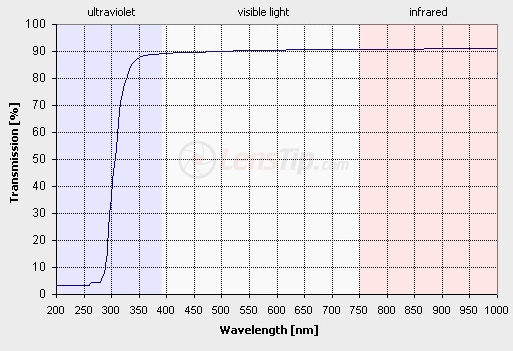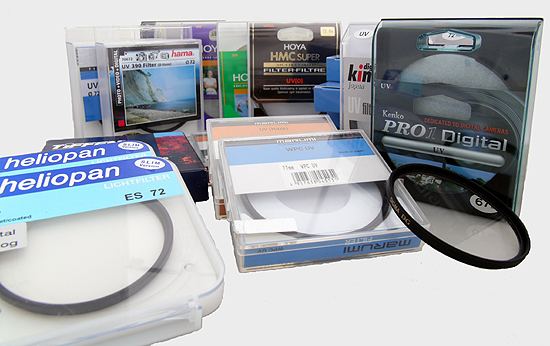UV filters test
2. A few words about UV radiation
The main task of the UV filters is to cut out the redundant ultraviolet radiation, which cannot be noticed by the human eye, but can be detected by the camera. But is it really a necessary addition to our photographic equipment? When is it worth using? To answer these questions we have to know what UV radiation is and how it affects our pictures.
The light that can be seen by the human eye is electromagnetic radiation with a wave ranging from 390 to 750 nm (some people can differentiate the color of a bit bigger range, like 380 to 780 nm).
Please Support UsIf you enjoy our reviews and articles, and you want us to continue our work please, support our website by donating through PayPal. The funds are going to be used for paying our editorial team, renting servers, and equipping our testing studio; only that way we will be able to continue providing you interesting content for free. |
- - - - - - - - - - - - - - - - - - - - - - - - - - - - - - - - - - - - - - - - - - - - - - - -

Radiation with an energy higher than in case of the visible light range (left in the picture above), from 400 to 10 nm, is called ultraviolet radiation.
Although the human eye isn’t able to observe the photons of this kind of energy; the CCD/CMOS detector or light sensitive film can actually register them. The detector construction is based on silicon photodiodes. Their sensitivity ranges from 190 to 1100 nm, which transcends the range from near ultraviolet light to visible light and infrared. As we can see, the detector is able to register much larger ranges of light than the human eye. A special filter placed under the sensor eliminates the close infrared range. This is done to avoid the situation when the IR radiation influences the camera color mapping. We cannot use the same filters in the case of ultraviolet. Why? It is beyond the need of our requirements since the lenses that we add to our cameras help us in this situation. The lenses, or more precisely, the built in glass of the lenses, efficiently reduce the amount of ultraviolet going into the digital detector. It’s an effect of small shortwave radiation transmission by the glass itself. This is why we cannot sunbathe through a window. To prove it we present a chart of light transmission through a perfectly flat glass within the 200 to 1000 nm range:

For waves shorter than 285 nm the glass transmits less than 10% of the light and for 200 nm or lesser range it is as little as 3.2%. But for the UV weve range close to the visible light limit the glass transmits as much as 90% of UV radiation. Should we worry about that? We know, from everyday life, that the image in the picture is in most cases the same as the image we see. It is caused by absorption and strong radiation dispersion by the earth’s atmosphere. Many kilometers above the earth the ozone absorbs some of the UV radiation. The closer to the earth’s surface, the more the UV radiation is absorbed. At the same time the light disperses while meeting atoms and the atmosphere, all the time building molecules along the way. The shorter the radiation waves, the stronger the dispersion. This effect is called the Rayleigh dispersion effect. The consequence of this effect is that blue light is 10 times more dispersed in the atmosphere than red light. This is why the cloudless sky has a beautiful blue color. However the 300 nm long UV radiation wave is dispersed 30 times stronger than red light. We cannot notice this effect but the film or CCD/CMOS detector can.
To understand this phenomenon more easily, think of the following example: during a fall morning we often observe very thick fog which can often reduce our visibility down to just a couple of meters. This effect is caused by the strong dispersion of light visible through the moist air that create the fog. We usually take out our cell phone at this moment and call our understanding boss to tell him that we will be late; we then go back home and sleep for two extra hours waiting for the fog to disappear. Why can the mobile phone transmission wave cut through the fog, but our vision can’t? This is possible thanks to the phone’s electromagnetic waves, which are much longer than our vision. For these waves the fog is completely transparent.
In summary, UV radiation is strongly absorbed by the atmosphere and the higher we are (on a plane or in the mountains) the more radiation we encounter. At the same time, the radiation is strongly dispersed, so when taking a picture of the Morskie Oko high mountain lake or Giewont Peak we get the impression that the image is slightly more blurred than we see with our naked eye. These are situations in which the use of UV filters would improve the picture quality.
Lens protection
This isn’t the only use for UV filters, however. For many years they have earned the name of protection filters. The reason is that the glass filter, which usually costs from several dozen to several hundred Polish zloty, protects the front lens, which sometimes costs several thousand Polish zloty. So that’s why many people use UV filters in everyday photography: not only to cut out the ultraviolet light, but also as an element of protection that doesn’t affect the picture quality.
The last sentence, however, isn’t completely true. We have to remember that each filter is also an additional optical element, which can increase the tendency of flares, can decrease the light transmission in a significant way, can change the color mapping or cause vignetting. So, when putting the UV filter on our lens we have to be aware of those facts. Therefore, it is important to choose the right filter so it doesn’t reduce the capabilities of the whole system. If we buy a 5000 Polish zloty lens we should be ready to pay as much as a couple hundred Polish zloty for solid protection for the lens. It doesn’t make sense to buy a cheap filter for an expensive lens since this can optically degrade our lens one or two classes down. The problem could be in choosing the right one from amongst a range with prices from 30 to 500 Polish zloty. Moreover, buying even the most expensive filter does not necessarily guarantee a satisfactory effect. Another complicating factor is that there aren’t many filter tests available either in professional literature or on the Internet. The Optyczne.pl/LensTip.com team has partially filled the gap and shares its impressions below of the tests of 20 UV filters available on the market.







